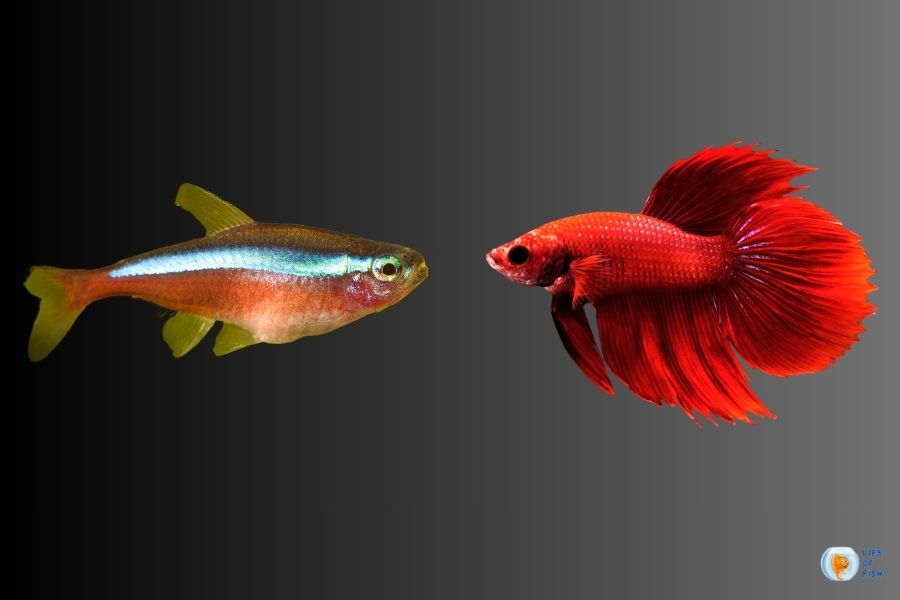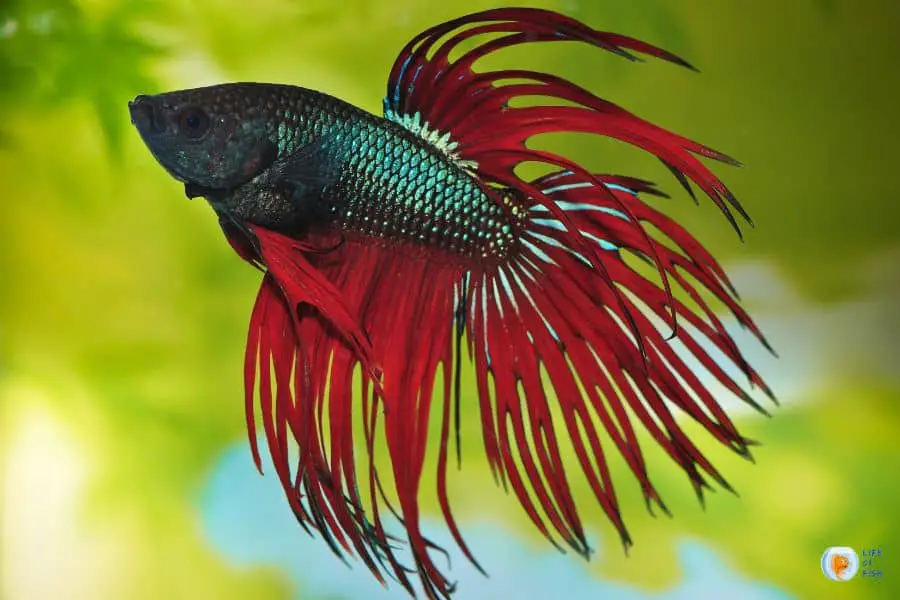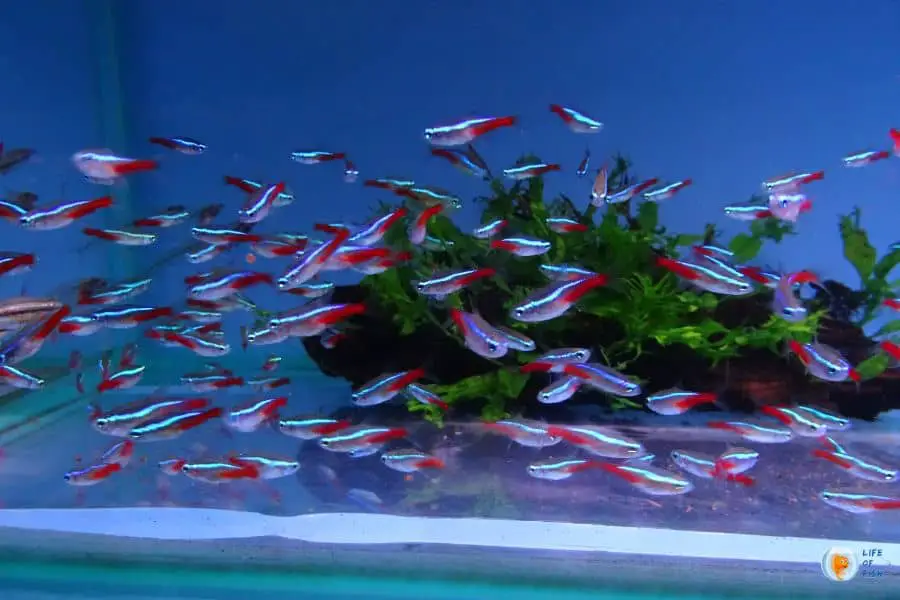The brilliant neon tetra and elaborate betta fish are two of the most popular freshwater species kept in home aquariums. Known for their bright colors and active nature, these eye-catching fish seem like they would make perfect tankmates.

But can you successfully keep neon tetras with bettas? Or will the betta’s aggressive tendencies put the tetras at risk?
The answer is, it depends! With careful planning and proper precautions, neon tetras and bettas can coexist peacefully. However, there are also situations where combining these fish is a recipe for disaster.
This complete compatibility guide will cover everything you need to know about housing neon tetras with bettas. Follow this advice, and you’ll be on your way to a stunning yet tranquil community aquarium with neon tetras and bettas!
Species Profiles: Neon Tetra & Betta Fish
Jump To
- 1 Species Profiles: Neon Tetra & Betta Fish
- 2 Tank Size and Setup Tips for Neon Tetras and Bettas
- 3 Caring for Water Quality with Neon Tetras and Bettas
- 4 Feeding Neon Tetras and Bettas a Proper Diet
- 5 Neon Tetra Behaviors to Watch For With Bettas
- 6 Minimizing Betta Aggression Towards Neon Tetras
- 7 Alternative Tankmates for Neon Tetras and Bettas
- 8 FAQs About Keeping Neon Tetras with Bettas
- 9 Avoiding Disaster with Neon Tetras and Bettas
- 10 Stunning Success Is Possible for Neon Tetras and Bettas
Before mixing any tropical fish, it’s important to understand the background, anatomy, and natural behaviors of each species. Let’s take a quick look at the key traits of neon tetras and betta fish.
Neon Tetra Overview
- Scientific Name: Paracheirodon innesi
- Origin: Streams in South America
- Size: Up to 1.5 inches long
- Lifespan: 5-10 years with proper care
- Temperament: Peaceful schooling fish
- Behaviors: Swim in tightly-knit groups
- Diet: Omnivore – eats small live and prepared foods
- Care Level: Easy community fish for beginners
- Appearance: Iridescent blue horizontal stripe
Betta Splendens Overview
- Scientific Name: Betta splendens
- Origin: Rice paddies in Southeast Asia
- Size: Up to 3 inches long
- Lifespan: 2-4 years with proper care
- Temperament: Aggressive, territorial
- Behaviors: Flare gills, spread fins to intimidate
- Diet: Insectivore – eats live or frozen meaty foods
- Care Level: Moderate – requires spaces and alone time
- Appearance: Vibrant colors, large flowing fins
Now that we’ve covered some background on each species, let’s dive into the tank requirements for housing them together.
Tank Size and Setup Tips for Neon Tetras and Bettas
The first key to success when mixing species is providing an adequately sized tank with an environment that meets both fishes’ needs. Here are the recommendations for neon tetras and bettas:
Minimum Tank Size
For a group of neon tetras plus a betta, aim for at least a 20 gallon aquarium. This gives adequate swimming areas for the tetras while providing the betta with plenty of territory.
In anything smaller, territorial disputes are almost guaranteed. Go bigger if possible – a 30 gallon tank is ideal.
Aquascape Considerations
Densely planting the tank is crucial, including floating plants like hornwort or water lettuce. This breaks up lines of sight and provides hiding spots for tetras if chased.
Leave open areas for the betta, but use tall plants like towards the back and sides to establish boundaries. Scatter caves and decor for additional breaks.
Add a gentle filter and low-flow heater suitable for a community tank. Keep water movement calm with minimal surface disruption.
Schooling Space
Neon tetras need sufficient room to school together, which is key to reducing aggressive nipping. Aim for at least 15-20 in a group so they feel secure.
Without adequate schooling space, fin nipping amongst themselves and towards the betta is more likely. A larger group dilutes aggression.
Betta Hideouts
Even in a bigger tank, create clear betta-only territory with caves or planted areas just for them. Floating betta logs provide a top-level retreat above the tetras’ mid-level schooling zone.
Multiple hideouts prevent the betta from feeling the need to constantly patrol and protect one space.
Now let’s go over the specific water care needs both species share.

Caring for Water Quality with Neon Tetras and Bettas
While neon tetras and bettas hail from very different parts of the world, their water parameter requirements are fortunately quite similar:
- Temperature Range: 74-82°F
- pH: Slightly acidic, 6.5-7.5
- Hardness: Soft to moderately hard
- Nitrogen Cycle: Fully cycled tank critical
Use a submersible heater to maintain a temperature around 78°F. For pH, natural methods like driftwood, peat, and Indian almond leaves work well to softly acidify water.
Both species are fairly adaptable to water conditions if acclimated slowly. But aim for clean, consistent parameters with these targets in mind.
Perform 25-30% partial water changes weekly, or twice weekly in smaller tanks. Always use a water conditioner to detoxify tap water before refilling the aquarium.
While their water needs align, feeding neon tetras and bettas requires a bit more finesse.
Feeding Neon Tetras and Bettas a Proper Diet
With different nutritional requirements, tailoring meals takes some consideration:
Neon Tetras
- Omnivores that accept variety
- Feed 2-3 small meals per day
- Flake foods, micropellets, brine shrimp
- Supplement with live daphnia, bloodworms
- Avoid overfeeding – feed only what they eat in 2 minutes
Bettas
- Insectivores prefer meaty foods
- Feed just 1-2 times per day
- Pellets, frozen bloodworms, brine shrimp
- Occasional treats like daphnia, shrimp, larva
- Let pellets soak before feeding to prevent bloating
When housing together, feed the tetras carefully measured amounts 2-3 times daily. Remove any uneaten food promptly.
Offer the betta a few soaked pellets or frozen worms just once at night. Target feed the betta to prevent the tetras from stealing all its food.
Now that we’ve covered the tank setup, water parameters, and diet for success, let’s discuss neon tetra behaviors and potential issues with bettas.
Neon Tetra Behaviors to Watch For With Bettas
While neon tetras are peaceful fish when kept in proper groups, some natural behaviors can trigger aggressive reactions from bettas:
Tight Schooling
In small tanks, tight schools darting around can resemble a threatening shoal to bettas. Give them lots of open space to loosely group and lazily swim.
investigations
Occasional curiosity and fin nipping towards the betta is possible, especially if underfed. Keep their attention on each other, not the betta.
Shimmering Stripes
Their shiny stripes serve to communicate within their school. But to a betta, it can look like flashing and flaring – acts of intimidation!
Surface Activity
Neons occasionally gulping air at the surface may seem to a betta like another fish invading its territory. Break the surface tension with plants.
Breeding Displays
Though rare in community tanks, breeding neon displays like shimmying can trigger male bettas to attack what looks like a spawning rival.
By optimizing their environment and behaviors, most issues can be avoided. But it takes vigilance and planning.
Speaking of aggression, let’s go over some strategies to curb typical betta behaviors that can put tetras at risk when sharing a tank.
Minimizing Betta Aggression Towards Neon Tetras
Even in optimal tank conditions, a betta’s pugnacious nature can endanger delicate tetras. Here are some tips to discourage aggression:
Pick Females or Plakat Males
Females and short-finned plakat males are less prone to flaring and fighting compared to long-finned bettas. Avoid extra-aggressive king bettas.
Avoid Visible Tank Mates
Lower water level a few inches to reduce what the betta sees above. Limit its line of sight with tall plants around the sides and rear.
Remove Reflections
Bettas attack their reflection. Position tank away from windows and sunlight. Dim lights or float plants to prevent flaring at glass.
Re-arrange Tank Weekly
Shift plants and decor to break territoriality. Create new zones and boundaries before it gets attached to any certain space.
Have Backup Plans Ready
Be prepared to add more hideouts or plants if trouble arises. Have alternate tank space ready in case the betta must be removed.
Even with precautions, you’ll want backup stocking ideas in case neon tetras and bettas don’t work out.

Alternative Tankmates for Neon Tetras and Bettas
If neon tetras and bettas prove to be a poor match in your tank, all is not lost! Here are some alternative tankmate options that better complement each species’ temperament and behaviors:
Good Tankmates for Neon Tetras
- Other small peaceful schooling fish like cardinal tetras, ember tetras, harlequin rasboras
- Bottom dwellers like pygmy corydoras, habrosus corydoras, khuli loaches
- Dwarf shrimp like cherry shrimp or amano shrimp
- Snails like nerite snails and mystery snails
Good Tankmates for Bettas
- Bottom feeding cory cats and peaceful loaches
- Snails and shrimp (though may prey on smaller varieties)
- Peaceful community fish like guppies, mollies, platies, gouramis
- Avoid fin nippers like tiger barbs or danios
Do your research before selecting tankmates, making sure your options have similar care needs and temperaments. Take it slow with careful introductions.
Now let’s wrap up with answers to some frequently asked questions about housing neon tetras with bettas.
FAQs About Keeping Neon Tetras with Bettas
Some common questions that come up when considering this fish combination include:
Are neon tetras fin nippers?
Healthy, well-fed neon schools in big enough tanks are not prone to excessive nipping. But hunger, small tanks, or small groups can trigger nippy behavior and fin damage.
Do bettas eat neon tetras?
Directly eating neon tetras is unlikely, but they may attack and kill them. Supervise closely, especially at feeding times, and have backup tanks available if aggression arises.
What size tank do neon tetras need with a betta?
For a group of at least 10 neon tetras plus one betta, start with a 20 gallon tank. More space is always better to disperse aggressive behaviors. Heavily planted tanks help too.
Should tetras or betta be added to the tank first?
Add the neon tetra school first, giving them a few weeks to settle in and claim territory. Slowly introduce the betta after so it doesn’t view the tetras as invaders.
How many neon tetras can live with a betta?
Shoot for at least 10-12 neon tetras so they feel secure schooling together. The more tetras, the less likely fin nipping will occur within the school or towards the betta.
Avoiding Disaster with Neon Tetras and Bettas
While neon tetras and bettas can coexist, they require careful planning and precaution. By following these dos and don’ts, you can avoid disaster when mixing them:
Do:
- Provide a 20+ gallon heavily planted tank
- Add the tetra school before introducing the betta
- Use calm tankmates with similar water needs
- Feed betta separately from tetra meals
- Have backup tank space ready just in case
Don’t:
- Skimp on tank size or plants/hideouts
- Try to co-house in 10 gallons or less
- Stock fin-nipping fish like tiger barbs
- Let water quality decline even slightly
- Feed live foods that trigger aggression
- Wait too long to separate fish if issues emerge
Stunning Success Is Possible for Neon Tetras and Bettas
While challenging at times, keeping neon tetras with bettas in a community aquarium can result in a beautifully balanced ecosystem.
Taking the time to learn the natural behaviors of each fish, tailoring their diet and environment to meet their needs, and having contingencies ready allows this combination to thrive.
With plenty of preparation and precaution, your schooling neon tetras and show-stopping betta can coexist in a tranquil tank that dazzles your eyes. Enjoy watching their colors shimmer as they gracefully swim among the plants.
We hope this guide has provided you with the key facts and tips to create aquarium success when mixing neon tetras and bettas. Let us know if you have any other questions!
Read Next:
Are Neon Tetras Hardy? Discover the Surprising Truth
Will Neon Tetras Eat Guppy Fry? The Correct Answer Is Here
Why Are My Neon Tetras Keep Dying? Uncovering the Cause of Death
